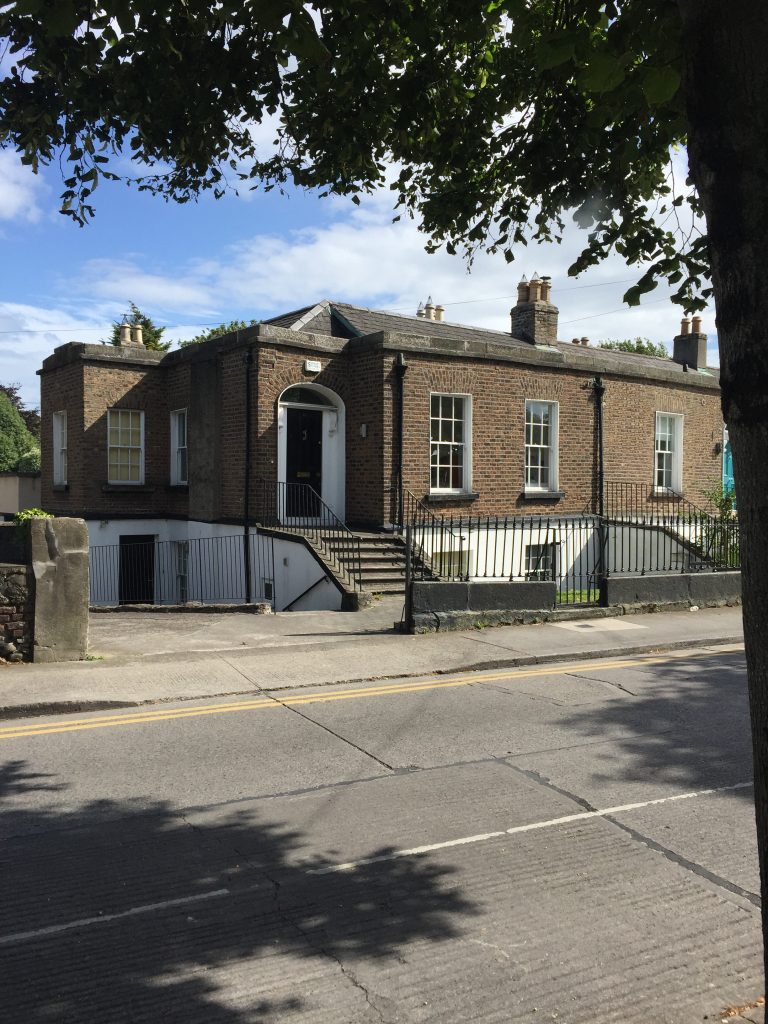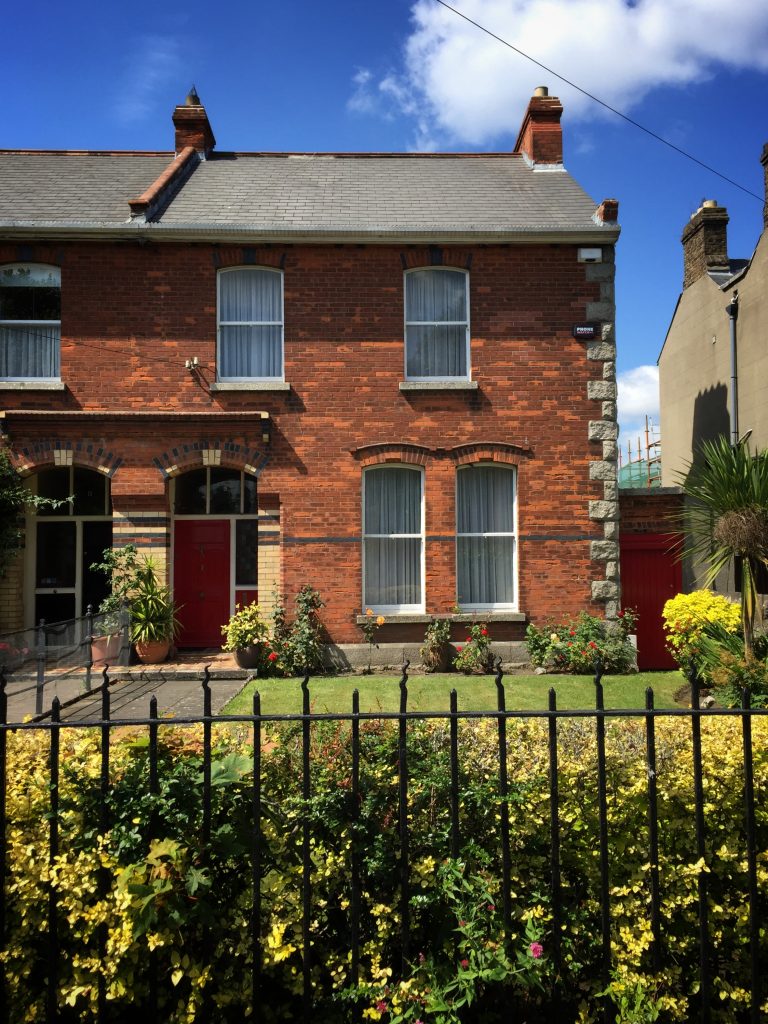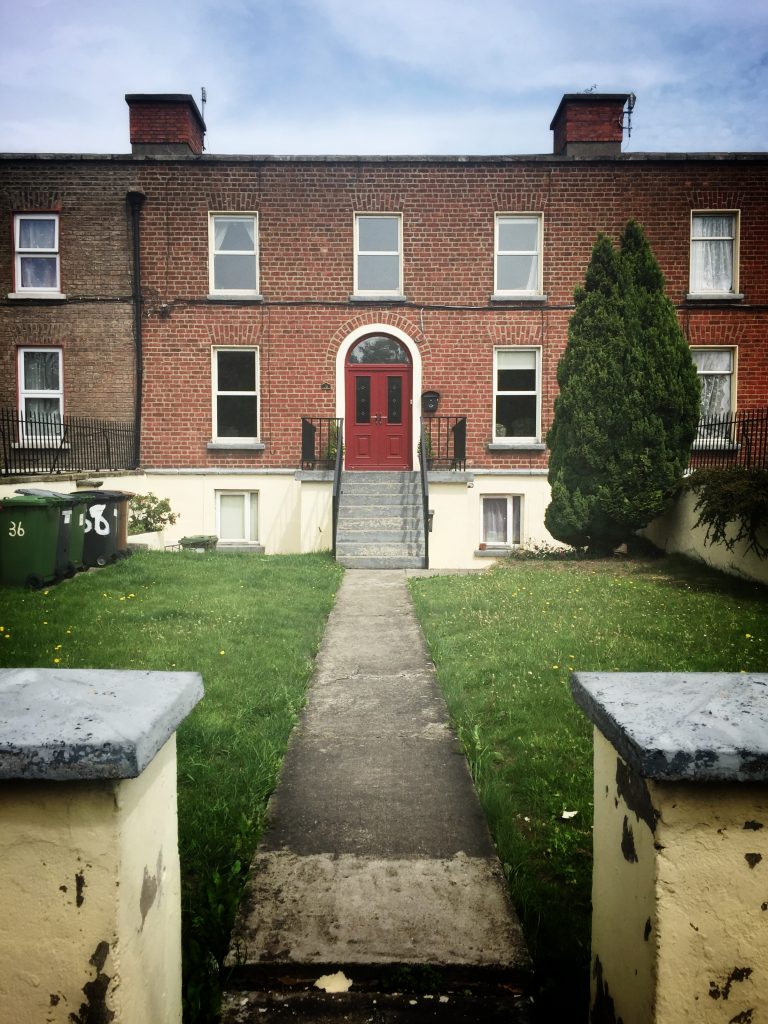All waited. Then wheels were heard from in front, turning: then nearer: horses’ hoof. A jolt. Their carriage began to move, creaking and swaying. Other hoofs and creaking wheels started behind. The blinds of the avenue passed and number ten with its craped knocker, door ajar. At walking pace.

All waited. Then wheels were heard from in front, turning: then nearer: horses’ hoof. A jolt. Their carriage began to move, creaking and swaying. Other hoofs and creaking wheels started behind. The blinds of the avenue passed and number nine with its craped knocker, door ajar. At walking pace.

The quotations above from Ulysses refer to the beginning of the funeral procession from Paddy Dignam’s house in Newbridge Avenue, Sandymount, from where it begins to make its way to Glasnevin Cemetery. The two quotes are identical save for the change in house number from number ten to number nine.
The first quote is from the book The Little Review “Ulysses” which gathers together the serialised Chapters of Ulysses from The Little Review. The episode was originally published in The Little Reviewin September 1918 and episodes were published as a book in 2015. The second, revised quote is from Ulysses as published in 1922.
Episode VI, known as the Hades Chapter was published in The Little Review in September 1918 in the United States. Episodes 1- XIV were published in serial form, but stopped before the book was complete, due to censorship issues. The full address of the house, as opposed to just the number of the house the procession is passing, 9 Newbridge Avenue, does not appear in print until Ulysses was published as a novel in 1922 where the address is listed in the Eumaeus episode towards the end of the book, when Bloom reads it in the obituary section of the Telegraph whilst in the cabman’s shelter near Butt Bridge.
Why did Joyce change the house numbers? In the Thom’s Directory of 1904, which Joyce used as a reference check for places and people listed in Ulysses, the house at 9 Newbridge Avenue is listed as vacant, whereas the house at 10 Newbridge Avenue is occupied by a Mr. P Gorman. Perhaps Joyce simply wanted to use an empty house in case of a law suit over the use of an occupied premises He had had more than enough trouble with Dubliners over similar issues. As the location was to be the scene of the death and removal of the occupant, Paddy Dignam, the issues were perhaps more sensitive than most.
This funeral procession begins with house numbers that were changed as Joyce’s writing developed. At the end of the Dignam funeral procession, as Glasnevin Cemetery is reached, a mistaken house location arises.
Mr. Power pointed.
—That is where Childs was murdered, he said. The last house.
—So it is , Mr Dedalus said. A gruesome case. Seymour Bushe got him off.
Murdered his brother. Or so they said.
—The crown had no evidence, Mr Power said.
—Only circumstantial, Martin Cunningham added. That’s the maxim of the law. Better for ninety-nine guilty to escape than for one innocent person to be wrongfully condemned.
The Childs murder did not take place in the last house, which was number 6 Bengal Terrace. The terrace consists of 6 houses as you can see in the image below. Thomas Childs lived in house number 5, the second last house in the terrace and the second house from the left in the image. Glasnevin Cemetery is immediately to the left of the photograph, adjoining the last house in the terrace. It could be that Joyce is mistaken, or it could be that he wants Simon Dedalus to be mistaken about the location of the Childs murder. Joyce knew Bengal Terrace well, as did his father, John Stanislaus Joyce, the model for Simon Dedalus. James Joyce’s aunt Josephine Giltrap’s family lived there.
Thomas Childs was murdered on September 2nd 1899. His brother, Samuel Childs was charged with the murder. The Childs case is examined in-depth in Adrian Hardiman’s book, Joyce in Court, James Joyce and the Law.
Hardiman writes about the Giltrap’s.
Josephine’s father, James Giltrap, a legal cost accountant, provides the first coincidental link between the Joyces and the Childs murder. On 1 September 1899, the day before Thomas Childs was killed, old James died in No.6 Bengal Terrace. His funeral left the house on the Monday and the preparations for it must have taken place over the weekend. The comings and goings of policemen, doctors, relatives and undertakers at No. 5 Bengal Terrace cannot have escaped the attention of mourners for Mr Giltrap, very probably including James Joyce. The inquest on Thomas Childs was opened in 5 Bengal Terrace on the day of Mr Giltrap’s funeral (where the jury viewed the body of Thomas Childs) and actually moved into number 6 to take evidence of a bedridden lady there.
It seems that Thomas Childs only lived in the house for a year. Thomas Childs is listed as living there in Thom’s Directory 1899, whereas the house is listed as vacant in the Thom’s Directory 1900. Thom’s Directory 1898 has a Mr. Edward Kelly living there, as he had done for a number of years.

Joyce changed the house numbers in Newbridge Avenue as the writing of Ulysses moved towards the novel’s publication. He may have made an error in describing the Child’s house as the last house in Bengal Terrace. But he was not alone. Although Hardiman writes that the Giltrap’s lived in Number 6, Thom’s Directory 1899 lists Thomas Childs as living in Number 5 and a John H. Giltrap as living in number 3 Bengal Terrace, which he had done for a number of years. A Mr. John Hilferty lived at Number 6 Bengal Terrace.
As well as confirming the houses that each of the residents lived in, The Irish Times of Friday September 22 1899, notes a confusion as to the district the murders took place in.
Mr. Clegg, addressing the magistrate, said that the prisoner, Samuel Childs, was charged with the murder of his own brother under circumstances of extreme and horrifying brutality. The case was known as “The Glasnevin murder” but he believed in fact that the place where the murder occurred was not Glasnevin.
Thom’s Directory lists Bengal Place as being in Finglas, rather than Glasnevin. The terrace was renumbered between 1910 and 1912, with number 5 becoming number 36 and number 6 becoming number 38.
Does any of this matter? Who cares about the names and numbers, people and places, real and imagined? Does it matter whether the murder took place in Finglas or Glasnevin, or that Mr. Giltrap’s first name is given as John and James in different places? Perhaps not. But if your interest is the development of literature, paralleled with the development of a city, then they do. James Joyce’s use of Thom’s Directory is interesting to many scholars, as is his moving of places and events in Dublin to suit his literary needs. In the first case, the moving of house number 10 to house number 9 was probably down to his careful study of Thom’s. In the second case his character’s location of the murder differs from Thom’s and other records such as The Irish Times. Joyce was possibly so familiar with the terrace that he did not check, and Thomas Childs only lived there for a short period of time.
People make mistakes. For the accused, Samuel Childs, mistakes and small details mattered, He was acquitted of the murder of his brother, as acknowledged by Simon Dedalus in Ulysses.
Thomas Childs and James Giltrap lived two doors, and died one day, apart. As they were from different religions they were buried in very different parts of the City. Vivien Igoe in her book, The Real People of Joyce’s Ulysses notes that James Giltrap died in the Hospice in Harold’s Cross and was moved across the city to be buried in mainly Catholic Prospect Cemetery in Glasnevin, beside his home in Bengal Terrace. James Giltrap, being a Protestant took an almost exactly opposite journey. He died in his home beside Prospect Cemetery, but was buried in Mount Jerome cemetery in Harold’s Cross. The difference between the reality of their two lives, their deaths and their own funeral processions, traversing the River Liffey, in contrast to the fictionalised funeral procession of Paddy Dignam is what I find most interesting.
Most routes in this blogpost involve a lot of advanced planning to create an interesting run and an interesting read. In this case I simply ran the funeral procession route from the Hades episode of Ulysses. It is one of the simplest routes that any of the characters in Ulysses take.
I am always working on a variety of blogposts and as I have developed more of them, they have got more complex both in terms of the running, the research and the writing. In this one picked what I thought was a simple topic of interest and prepared to run.
My original interest and theme was the different house numbers at the start and end of the route, which I think make an interesting counterpoint. As my research developed and the blogpost began to take shape, what became of greater interest was the story of the closeness of the death, both in time and in space of Thomas Childs and James Giltrap and the difference in their funeral processions.
One interesting aside is that, as noted by Robert Martin Adams in Surface and Symbol, The Consistency of James Joyce’s Ulysses (p.174) Bloom’s client in Ulysses, Alexander Keyes was in reality one of the original jurors on the Childs case.
There are many other events and people that can be linked to this route and episode from Ulysses. I plan to return to it.
Adams, R.M. (1967) Surface and Symbol, The Consistency of James Joyce’s Ulysses, New York, United States: Oxford University Press.
Hardiman, A. (2017). Joyce in Court. 1st ed. London: Head of Zeus.
Gunn, I. and Hart, C. (2004) James Joyce’s Dublin: A Topographical Guide to the Dublin of Ulysses. London, United Kingdom: Thames & Hudson.
Joyce, J. (1998) Ulysses. Edited by Hans Walter Gabler, Wolfhard Steppe, and Claus Melchior. Afterword by Michael Gordon edn. New York, United States: Vintage Books.
Joyce, J. (2015) The Little Review “Ulysses”. Edited by Mark Gaipa, Sean Latham, and Robert Scholes. New Haven, CT, United States: Yale University Press.
McCarthy, J.F. and Rose, D. (1991) Joyce’s Dublin: A Walking Guide to Ulysses. New York, United States: St. Martin’s Press
Nicholson, R. (2015) The Ulysses Guide. Dublin, Ireland: New Island Books.
Igoe, V. (2016) The Real People of Joyce’s Ulysses: A Biographical Guide. Dublin, Ireland: University College Dublin Press.
There is a longer bibliography of background material here
You can see more of my research output on the Technological University Dublin repository Arrow, here